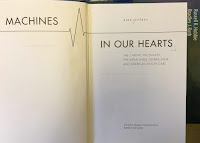The cardiac pacemaker represents one of the most important contributions of physics and engineering to medicine. In Chapter 7 of the 4th edition of Intermediate Physics for Medicine and Biology, Russ Hobbie and I describe the pacemaker.
Cardiac pacemakers are a useful treatment for certain heart diseases [Jeffrey (2001); Moses et al. (2000); Barold (1985)]. The most frequent are an abnormally slow pulse rate (bradycardia) associated with symptoms such as dizziness, fainting (syncope), or heart failure. These may arise from a problem with the SA node (sick sinus syndrome) or with the conduction system (heart block)….Several years ago, I taught a class about pacemakers and defibrillators as part of Oakland University’s honors college. The class was designed to challenge our top undergraduates, but not necessarily those majoring in science. Among the readings for the class was a profile in the March 1995 issue of IEEE Spectrum about Wilson Greatbatch (Volume 32, Pages 56-61). The article tells the story of Greatbatch’s first implantable pacemaker:
A pacemaker can be used temporarily or permanently. The pacing electrode can be threaded through a vein from the shoulder to the right ventricle (transvenous pacing, Fig. 7.31) or placed directly in the myocardium during heart surgery.
Greatbatch was on one team that had been summoned by William C. Chardack, chief of surgery at Buffalo’s Veteran’s Administration Hospital, to deal with a blood oximeter. The engineers could not help with that problem, but the meeting for the inventor was momentous: finally, after many previous attempts, he had met a surgeon who was enthusiastic about prospects for an implantable pacemaker. The surgeon estimated such a device might save 10000 lives a year.
Three weeks later, on May 7, 1958, the engineer brought what would become the worlds first implantable cardiac pacemaker to the animal lab at Chardack’s hospital. There Chardack and another surgeon, Andrew Gage, exposed the heart of a dog, to which Greatbatch touched the two pacemaker wires. The heart proceeded to beat in synchrony with the device, made with two Texas Instruments 910 transistors. Chardack looked at the oscilloscope, looked back at the animal, and said, “Well, I’ll be damned.”
 |
| Machines in Our Hearts, by Kirk Jeffrey. |
If theirs [Chardack and Greatbatch] was not the only pacemaker of the 1950s, it appears to be the only one that survives today in the collective memory of the community of physicians, engineers, and businesspeople whose careers are tied to the pacemaker… The Chardack-Greatbatch pacamaker stood out from other prototype implantables of the late 1950s not because it was first or clearly a better design, but because it succeeded in the U.S. market as did no other device.Jeffrey also discusses at length Greatbatch’s contributions to developing the lithium battery.
Because of his prestige in the pacing community and his effectiveness as a champion of technology be believed in, Greatbatch was able almost single-handedly to turn the industry to lithium; in fact by 1978, a survey of pacing practices indicated that only 5 percent of newly implanted pulse generators still used mercury-zinc batteries.Greatbatch was inducted into the National Inventor’s Hall of Fame in 1986. His citation says
Wilson Greatbatch invented the cardiac pacemaker, an innovation selected in 1983 by the National Society of Professional Engineers as one of the two major engineering contributions to society during the previous 50 years. Greatbatch has established a series of companies to manufacture or license his inventions, including Greatbatch Enterprises, which produces most of the world's pacemaker batteries.Below are some links related to Wilson Greatbatch that you might find useful.
Invention Impact
His original pacemaker patent resulted in the first implantable cardiac pacemaker, which has led to heart patient survival rates comparable to that of a healthy population of similar age.
Inventor Bio
Born in Buffalo, New York, Greatbatch received his preliminary education at public schools in West Seneca, New York. In 1936 he entered military service and served in the Atlantic and Pacific theaters during World War II. He was honorably discharged with the rating of aviation chief radioman in 1945. He attended Cornell University and graduated with a B.E.E. in electrical engineering in 1950. Greatbatch received a master's from the State University of New York at Buffalo in 1957 and was awarded honorary doctor's degrees from Houghton College in 1970 and State University of New York at Buffalo in 1984. Although trained as an electrical engineer, Greatbatch has primarily studied interdisciplinary areas combining engineering with medical electronics, agricultural genetics, the electrochemistry of pacemaker batteries, and the electrochemical polarization of physiological electrodes.
An article about Greatbatch published by the Lemelson Center for the Study of Invention and Innovation: http://invention.smithsonian.org/centerpieces/ilives/lecture09.html
A video about Greatbatch produced by the Vega Science Trust: http://www.vega.org.uk/video/programme/248
Biography of Wilson Greatbatch on the Heart Rhythm Society website:
http://www.hrsonline.org/News/ep-history/notable-figures/wilsongreatbatch.cfm
New York Times obituary: http://www.nytimes.com/2011/09/28/business/wilson-greatbatch-pacemaker-inventor-dies-at-92.html
BBC obituary: http://www.bbc.co.uk/news/world-us-canada-15085056
A video honoring Wilson Greatbatch, the 1996 Lemelson-MIT Lifetime Achievement Award Winner.
Learn about Wilson Greatbatch, 1996 Lemelson-MIT Lifetime Achievement Award Winner.
https://www.youtube.com/embed/WLZBl118Ads
https://www.youtube.com/embed/WLZBl118Ads


